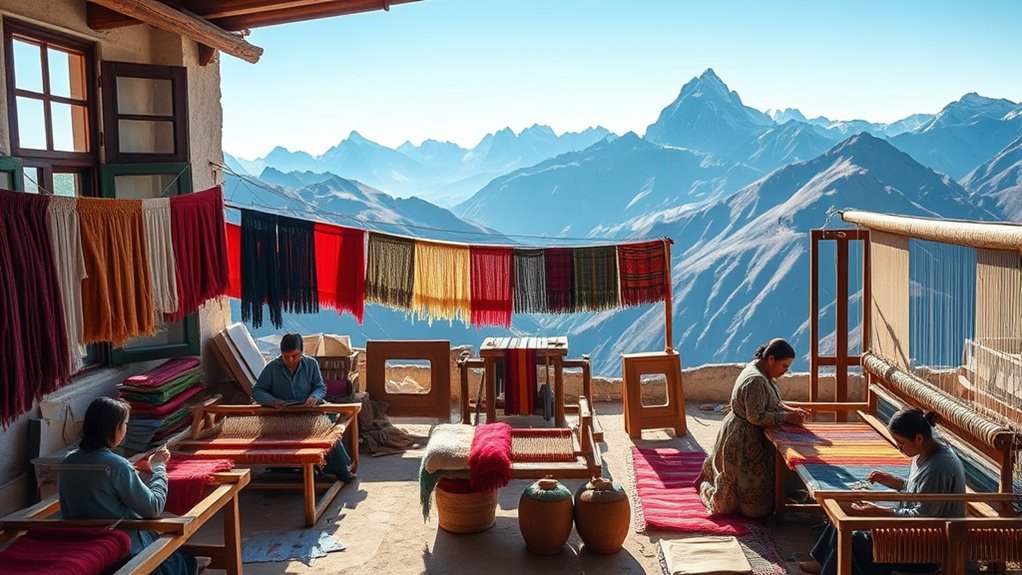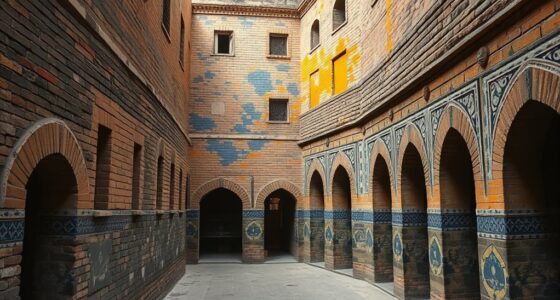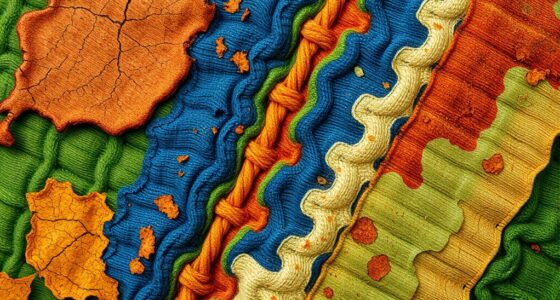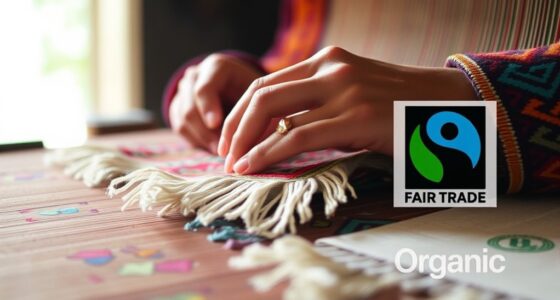High-altitude weaving workshops showcase the vibrant textile traditions of mountain communities, where artisans craft textured textiles amid breathtaking scenery of peaks and valleys. You’ll see skillful techniques passed down through generations, using natural fibers and dyes sourced locally. These photos reveal the harmony between culture and environment, capturing artisans’ personal stories and their resilience in remote settings. Continue exploring to discover how these ancient practices adapt and thrive in today’s world.
Key Takeaways
- Showcase artisans working on traditional looms amid mountainous scenery, highlighting scenic settings and cultural atmosphere.
- Capture detailed shots of weaving techniques, tools, and natural dyes used in high-altitude workshops.
- Include portraits of artisans sharing stories and personal patterns, emphasizing cultural significance and community bonds.
- Document the integration of modern influences, such as digital tools and contemporary motifs, within traditional practices.
- Depict the challenges faced, like resource scarcity and weather, alongside resilience and collaborative efforts of artisans.
The Cultural Significance of Weaving in Mountain Communities

In many mountain communities, weaving is more than just a craft; it’s a vital expression of cultural identity and tradition. You’ll notice how weaving festivals celebrate this heritage, bringing communities together to honor their history through vibrant displays of ceremonial textiles. These textiles aren’t merely decorative; they embody stories, beliefs, and social status. When participating in or observing weaving festivals, you see how every pattern and color holds symbolic meaning, passed down through generations. Weaving sustains cultural continuity, reinforcing community bonds and cultural pride. It’s a living tradition that links the past with the present, allowing you to experience the profound significance woven into every textile. Through these practices, mountain communities preserve their unique identities and cultural expressions. Additionally, weaving often involves traditional techniques that have been preserved over centuries, further enriching the cultural heritage. The intricate patterns and symbolism used in textiles reflect the community’s history and cosmology, making each piece a story in fabric. The preservation of artisanal techniques is essential to maintain authenticity and cultural integrity. By safeguarding these cultural practices, communities ensure that their heritage remains vibrant and relevant for future generations. The preservation of cybersecurity measures in documenting and sharing these artisanal traditions is crucial to protect their authenticity and prevent cultural dilution.
Exploring the Scenic High-Altitude Workshops
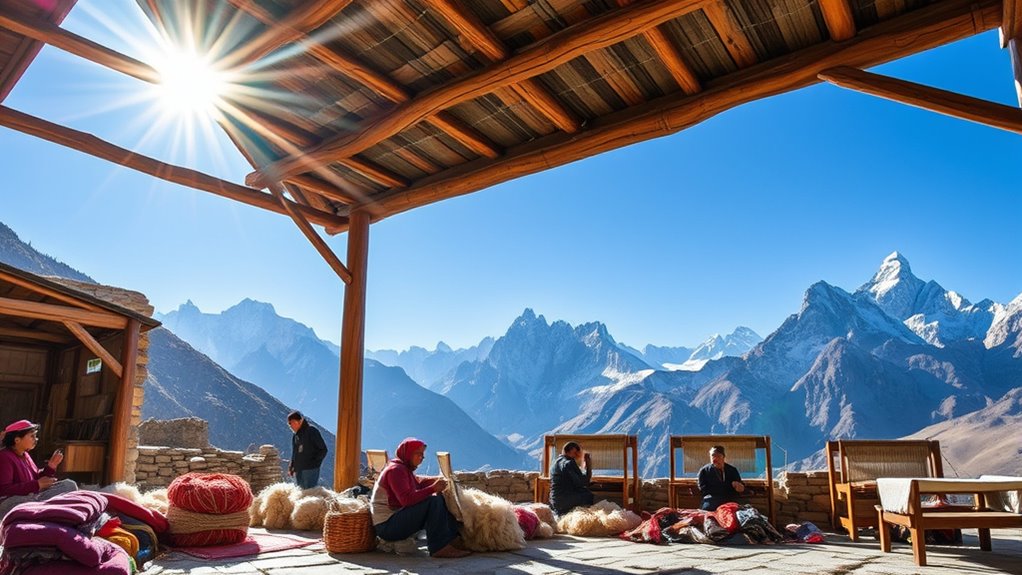
You’ll be captivated by the breathtaking mountain settings that surround these workshops, offering stunning views at every turn. The authentic cultural atmosphere makes the experience feel genuine and immersive. As you explore, you’ll feel connected to both the landscape and the traditions woven into every piece. Incorporating traditional healing methods, these workshops highlight the importance of cultural heritage in health and wellness. The use of unique and wicked planters as inspiration in the craft reflects the creativity and diversity of local artisans. Additionally, the integration of essential oils derived from local plants emphasizes the region’s rich herbal traditions and natural remedies. Implementing security measures can help protect the integrity of these culturally significant practices and materials, fostering a sense of emotional well-being among participants.
Breathtaking Mountain Settings
Set against the majestic backdrop of towering peaks and sweeping valleys, high-altitude weaving workshops offer an unparalleled sense of inspiration. As you stand there, you’ll notice the vibrant mountain flora thriving in the thin air, a demonstration to the resilience required at high altitudes. The scenery’s breathtaking, with rugged cliffs and clear blue skies, fueling your creativity. You’ll quickly realize that altitude adaptation isn’t just a necessity for the locals; it shapes your experience too. The crisp mountain air invigorates your senses, helping you focus on every intricate detail of the weaving process. The importance of contrast ratio in projectors can be appreciated here, as the stunning landscape enhances the visual clarity and depth of the images. Surrounded by such stunning natural beauty, you feel both humbled and motivated, as the landscape itself becomes a living part of your artistic journey. Additionally, the local culture and traditions surrounding high-altitude weaving add depth and meaning to your artistic exploration, enriching your overall experience.
Authentic Cultural Atmosphere
The high-altitude weaving workshops pulse with an authentic cultural atmosphere that immerses you in local traditions. As you explore, you notice how the surrounding urban architecture blends traditional and modern styles, reflecting the community’s history and progress. The air is filled with the aroma of culinary traditions, from hearty stews to local bread, offering a taste of daily life. Conversations with artisans reveal stories passed down through generations, emphasizing the importance of preserving cultural heritage. The vibrant colors of woven textiles echo the lively spirit of the region, while the setting’s simple yet meaningful architecture underscores a deep connection to history. Additionally, textile craftsmanship plays a vital role in maintaining the cultural identity of the community, highlighting the significance of traditional weaving techniques. Together, these elements create a genuine, immersive experience that transports you into the heart of high-altitude culture.
Traditional Techniques Passed Down Through Generations

Traditional weaving techniques have been meticulously preserved and passed down through generations, guaranteeing that each pattern and method remains authentic. This ongoing textile preservation relies on skilled artisans sharing their knowledge and skills, keeping ancient methods alive. Through artisan collaborations, techniques are refined and adapted while maintaining tradition. Incorporating sound vibrations into cultural practices is believed to enhance the transmission of knowledge and reinforce community bonds. Here are four key aspects that keep these techniques vibrant:
Traditional weaving is preserved through skilled artisans sharing knowledge and collaborating to keep ancient methods alive.
- Hands-on learning: Young weavers apprentice under elders, mastering traditional tools and methods. Skill transfer plays a crucial role in ensuring that craftsmanship endures across generations. Additionally, the use of natural fibers ensures the sustainability and authenticity of the textiles.
- Community workshops: Local gatherings reinforce cultural continuity and skill transfer. Engaging in cultural education helps sustain the significance of traditional weaving in modern times.
- Use of natural dyes: Techniques for dyeing with plants are carefully maintained to preserve color authenticity. This practice also supports environmental sustainability within traditional textile arts.
- Cultural storytelling: Each pattern encodes stories, passing history along with craft. These narratives deepen the cultural value of each woven piece and strengthen communal identity.
These practices ensure the legacy of high-altitude weaving endures, blending tradition with community effort.
The Artistry Behind Vibrant Textile Patterns
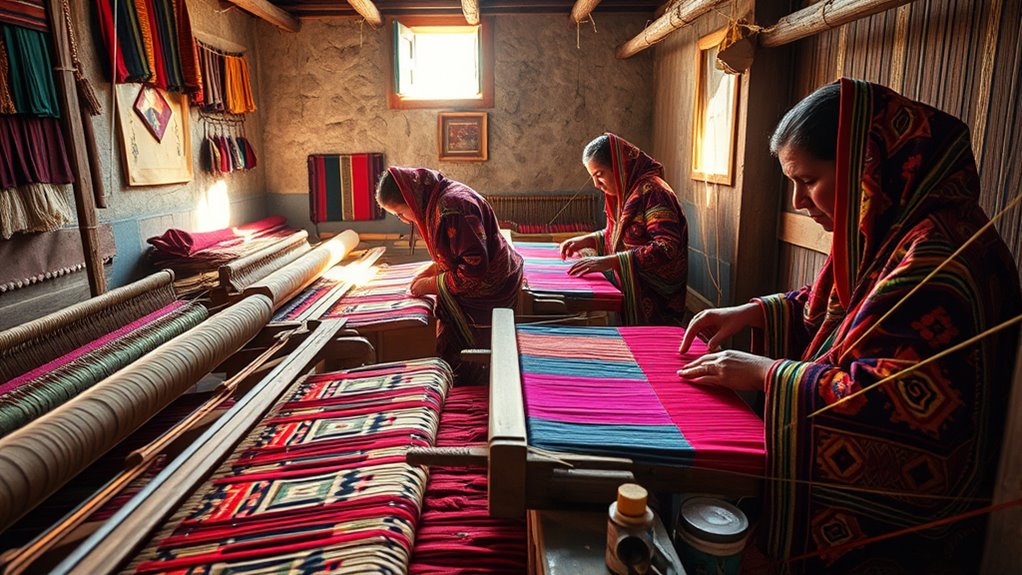
You can see how traditional dye techniques create the bold, lasting colors that define these textiles. The patterns often carry deep symbolism, telling stories or representing community beliefs. Exploring these motifs reveals the artistry and cultural significance woven into every fabric. Additionally, understanding the global economic outlook can provide context for the cultural exchange and market demand influencing textile production.
Traditional Dye Techniques
While vibrant textile patterns captivate the eye, their brilliance stems from centuries-old dye techniques that artisans carefully preserve. These methods, rooted in tradition, guarantee the longevity of the colors and patterns you admire. You’ll discover how natural dyes, derived from plants, minerals, and insects, are skillfully prepared through processes like boiling and fermentation. Understanding these techniques reveals their role in textile preservation amid evolving market dynamics. Here are four key aspects:
- Use of natural dyes ensures color fastness and sustainability.
- Precise mordanting techniques enhance dye adherence and vibrancy.
- Artisans adapt traditional methods to meet modern market demands.
- Preservation of these techniques supports cultural identity and economic stability.
Symbolism in Motifs
The vibrant motifs woven into high-altitude textiles often carry profound symbolic meanings that reflect the community’s beliefs, history, and environment. You’ll notice that each motif symbolizes specific ideas or stories, making pattern meaning deeply personal and cultural. For example, certain geometric shapes represent natural elements like mountains or rivers, while animal figures symbolize protection or fertility. The motif symbolism isn’t random; it’s intentional, conveying messages passed down through generations. As you observe these textiles, you’ll see how artisans embed their worldview into every stitch, transforming functional clothing into storytelling art. Understanding the pattern meaning enriches your appreciation, revealing layers of cultural significance woven into each colorful textile. These motifs are living symbols, connecting past and present through vibrant craftsmanship.
Tools and Materials: Crafting With Nature’S Resources
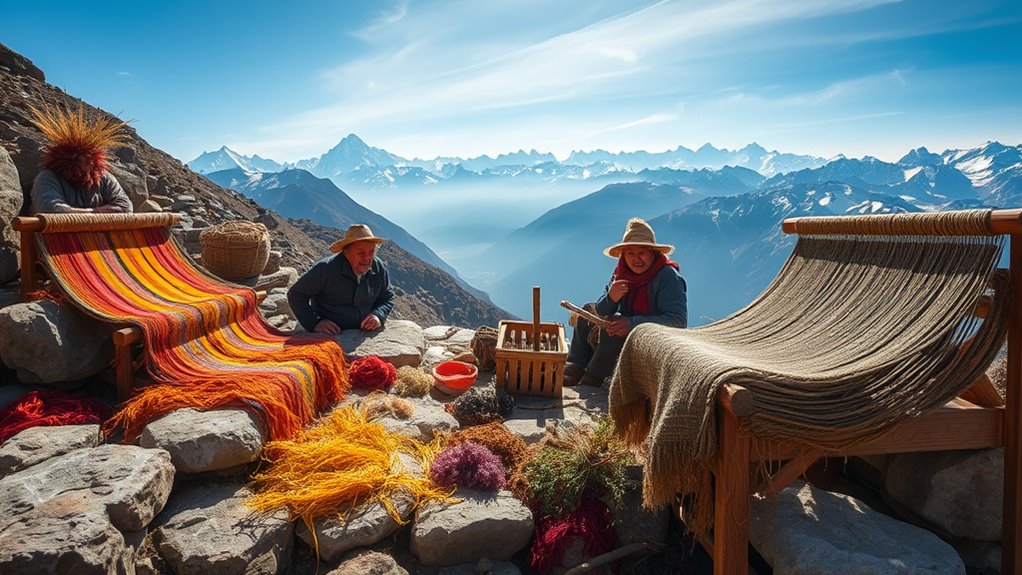
In high-altitude weaving workshops, artisans skillfully utilize natural resources found in their environment to craft their textiles. You’ll see they primarily work with natural fibers, which they gather from local plants or animals, ensuring sustainability. They also create vibrant colors using sustainable dyes derived from plants, minerals, and insects. Here are some tools and materials they rely on:
- Hand-spun fibers from llamas, alpacas, or native plants
- Wooden loom frames crafted locally
- Natural dyes from cochineal insects or local plant roots
- Traditional needles made from bone or wood
These resources highlight their deep connection to nature, enabling them to produce beautiful, eco-friendly textiles that carry cultural significance and environmental respect.
Challenges Faced by Artisans in Remote Environments
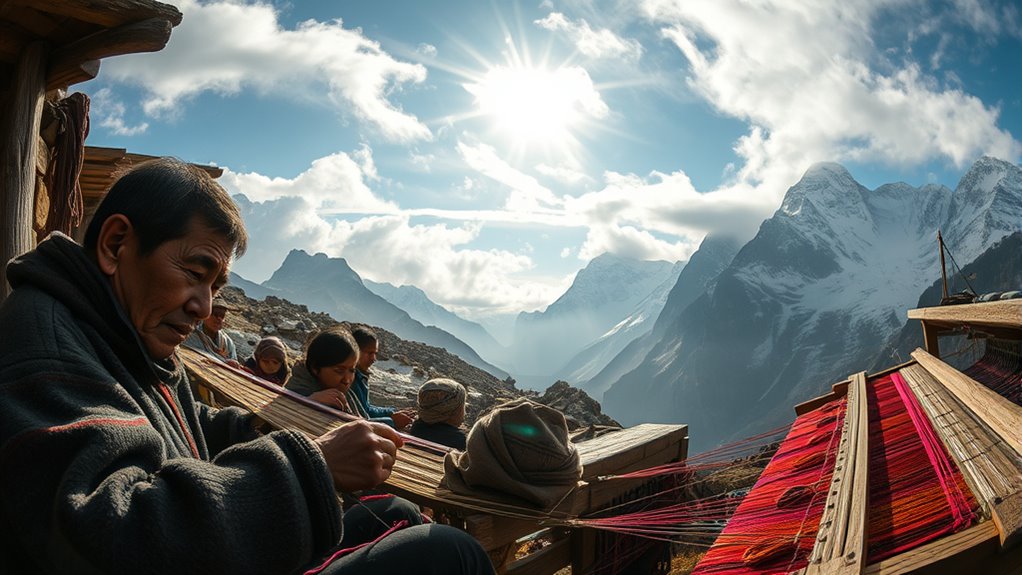
Artisans working in remote high-altitude regions often face significant obstacles that hinder their craft. Mountain isolation makes it difficult to access markets, supplies, and skilled support, leaving you cut off from broader networks. Limited transportation options mean deliveries are infrequent, so you must rely on what’s locally available, which often leads to resource scarcity. This scarcity affects not just your materials but also tools and essential equipment. Harsh weather conditions and thin air can slow production and impact your health, adding physical challenges to the process. Despite these hurdles, your resilience keeps the tradition alive. Still, mountain isolation and resource scarcity remain persistent challenges, requiring creativity and determination to continue weaving in such demanding environments.
Personal Stories: Artisans’ Lives and Inspirations
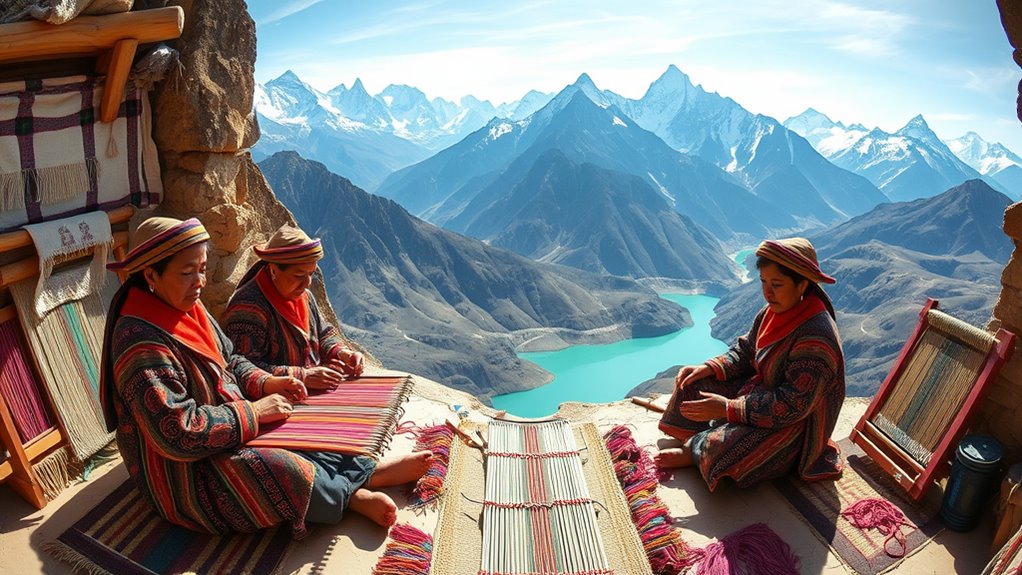
Despite the hardships of remote high-altitude living, your stories reveal deep personal connections to your craft. Through weaving workshops and artisan collaborations, you share what inspires you daily.
- The community bonds formed during shared weaving sessions that sustain your spirit.
- Personal stories behind each pattern, reflecting traditions and individual creativity.
- How collaborations with other artisans help refine your skills and introduce new ideas.
- The inspiration drawn from your environment—the mountains, sky, and local stories—that shape your work.
Your experiences highlight that weaving is more than a craft; it’s an essential part of your identity. Each thread you weave tells a story of resilience, culture, and personal passion, connecting you deeply with your art and community.
The Role of Weaving in Preserving Cultural Identity
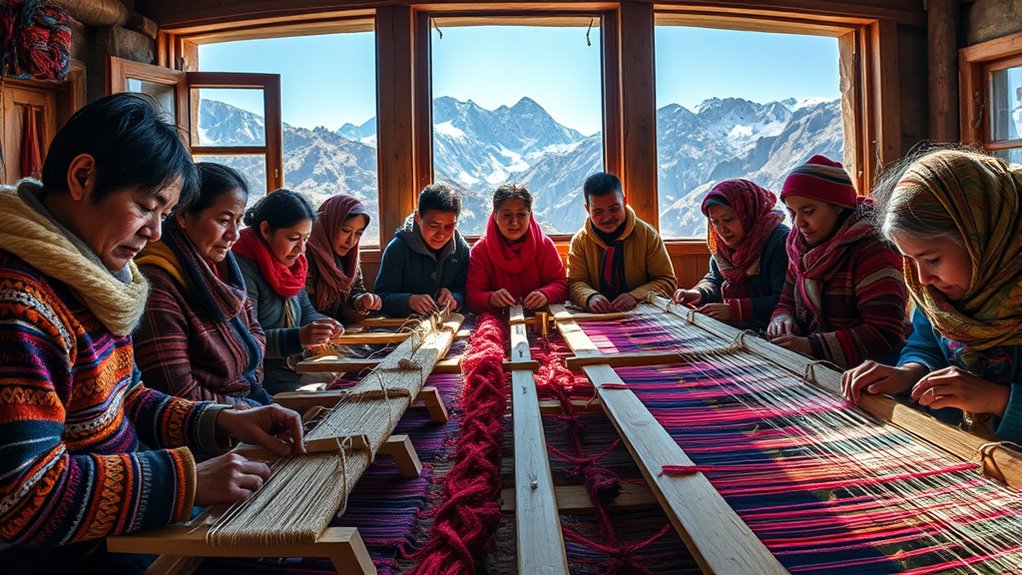
Weaving plays a critical role in maintaining and passing down cultural identity, serving as a tangible expression of your community’s history and values. Through weaving symbolism, your community encodes stories, beliefs, and social status into every textile. These designs act as visual language, linking generations and reinforcing shared identity. Textile preservation guarantees that traditional techniques and patterns are not lost over time, safeguarding your cultural heritage. Every woven piece becomes a living artifact, reflecting your community’s unique worldview and history. By continuing these practices, you keep cultural symbols alive and relevant. Weaving therefore becomes more than craft—it’s an essential act of cultural resilience, connecting the past with the present and guaranteeing your community’s identity endures.
The Impact of Modern Influences on Traditional Weaving
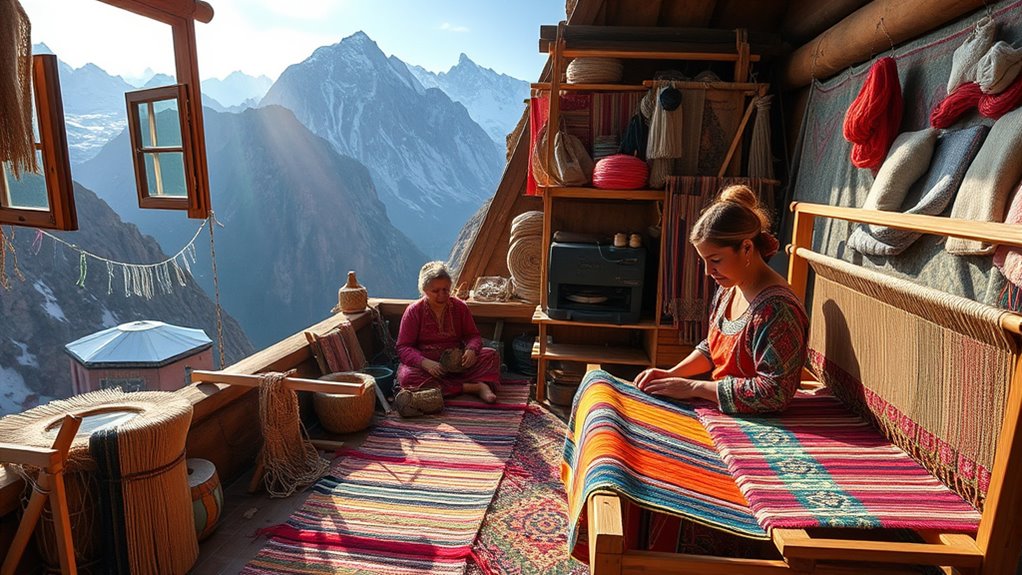
Modern influences have considerably reshaped traditional weaving practices, introducing new materials, techniques, and styles that challenge age-old methods. You now see how modern fashion trends inspire weavers to experiment beyond traditional designs. Digital influence plays a key role, connecting artisans with global markets and ideas. Here are four ways this change manifests:
- Incorporation of synthetic fibers aligned with modern fashion demands
- Adoption of digital platforms for marketing and selling woven products
- Fusion of traditional motifs with contemporary aesthetics
- Use of digital tools to design and innovate weaving patterns
These influences push artisans to balance tradition with innovation, creating vibrant, relevant textiles that honor heritage while embracing the future.
Frequently Asked Questions
How Do High-Altitude Conditions Affect Weaving Techniques and Materials?
High-altitude conditions influence weaving techniques and materials by causing altitude-induced fabric changes and shaping mountain wind weaving techniques. You notice that the thinner air affects fiber strength and flexibility, prompting adjustments in your methods. The mountain wind challenges your work, encouraging you to develop specialized techniques to stabilize weaves. These environmental factors push you to innovate, making your textiles uniquely suited to withstand the harsh conditions while maintaining traditional craftsmanship.
What Are the Specific Cultural Symbols Embedded in Traditional Textile Patterns?
You might think textile patterns are just pretty designs, but they’re packed with symbolic motifs that tell cultural narratives. These symbols often represent stories, beliefs, or history, embedding meaning into every stitch. From animals signifying strength to geometric shapes denoting community, each pattern reflects a rich cultural identity. So, by examining these motifs, you explore a visual language that preserves traditions and expresses collective memories, making textiles much more than decorative art.
How Do Artisans Adapt to Environmental Challenges During Workshops?
During workshops, you notice artisans adapt to environmental challenges through altitude adaptation and environmental resilience. They select resilient materials, adjust weaving techniques for cooler temperatures, and modify dyeing processes to withstand high-altitude conditions. By employing these strategies, they guarantee their craft survives and thrives despite harsh weather. Your participation reveals how their resourcefulness maintains cultural traditions while embracing environmental realities, emphasizing their deep connection to the landscape and commitment to sustainable craftsmanship.
What Is the Economic Impact of Weaving on Mountain Communities?
You’ll see that weaving boosts mountain communities’ economies by creating diverse market opportunities. It encourages market diversification, helping artisans reach new customers locally and internationally. Export opportunities expand income sources, empowering artisans to improve living standards. As you observe, this craft not only preserves cultural heritage but also drives economic resilience, making weaving a essential activity for sustainable development in mountain regions.
How Are Younger Generations Involved in Sustaining Traditional Weaving Practices?
You see that younger generations are actively involved in sustaining traditional weaving practices through intergenerational knowledge sharing and community involvement. They learn from elders, preserving skills and cultural heritage. By participating in local workshops and markets, they keep the craft alive, ensuring its relevance. Your engagement helps bridge the gap between tradition and modernity, fostering pride and continuity in these mountain communities.
Conclusion
You’ve seen how high-altitude weaving keeps mountain cultures alive, with over 60% of artisans passing down these skills for generations. These vibrant textiles aren’t just beautiful—they’re essential to preserving history and identity. Despite tough conditions, your artisans show incredible resilience and artistry. By supporting these workshops, you help keep their rich traditions thriving, ensuring these breathtaking crafts continue to inspire and connect communities for years to come.
